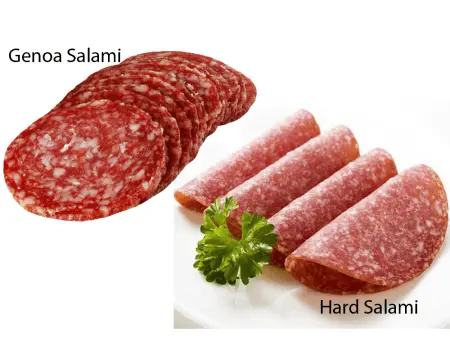Salami may be just a type of sausage, but it is actually a very versatile product. It can be a pizza topping, paired with wine and cheese, mixed with other ingredients to make a sandwich filling, or eaten as a simple appetizer.
If you are a salami fan, or have bought salami before, you are probably aware that there is not just one type of salami. There are many types of salami, but the two most common are Genoa salami and hard salami. Are they the same? Well, both are delicious and they almost look the same, but they are different. The difference between the two will be discussed in this article.
Summary Table
| Genoa Salami | Hard Salami |
| Originated in Genoa, Italy | Originated in Central Europe |
| Mainly contains pork but may also contain beef; higher fat content | Mainly contains beef but may also contain pork |
| Seasoned with spices, herbs, peppercorns, and wine | Not seasoned with peppercorns |
| Undergoes a curing process | Cured, dried, then smoked |
| Has a greasy and fermented taste; soft texture | Darker in color; firmer, dry and coarse texture |
Descriptions

Genoa salami is named after a place in Italy – Genoa – where it originated. In Genoa, it was easier to raise pigs than cattle because of the lack of plains, so most Genoese foods feature pork as the main ingredient.
Because Genoa salami mainly contains pork (although small amounts of beef may be also be added), it contains a high level of fat and is very greasy. Before it goes through curing, herbs, peppercorns, wine, garlic and salt are added to it for flavor.
It has a relatively soft and fermented taste because of the wine added to it in the process.
On the other hand, hard salami is believed to have originated in Central Europe. It is made mainly from beef but may also contain pork, so it is a little bit darker than most types of sausages. Other ingredients like herbs, spices and salt are added. As well as being cured and dried, hard salami also undergoes a smoking process.
Hard salami, as the name suggests, is noticeably harder or firmer than other sausages. It also has a coarse and dry texture.
Genoa vs Hard Salami
What, then, is the difference between Genoa and hard salami?
Although both sausages may contain a combination of beef and pork, Genoa is mainly made from pork while hard salami is mainly made from beef.
Other ingredients like spices, herbs, peppercorns, and wine are added to Genoa salami but hard salami is not seasoned with peppercorns. Additionally, Genoa has a higher fat content than hard salami. Both types of salami go through a curing process. However, only hard salami undergoes smoking.
When it comes to color, texture and taste, hard salami is darker and firmer than Genoa.
Because it contains wine, Genoa salami has a fermented taste and a greasy and softer texture while hard salami has a dry and coarse texture. In terms of origin, Genoa originated in Genoa, Italy while hard salami originated in Central Europe.
Nutritional Value
There’s also a difference in the nutritional value of Genoa and hard salami. For instance, Genoa salami has a higher amount of B vitamins that add up to about 20% of the daily recommended value.
On the other hand, hard salami has a slightly lower amount of B vitamins. But it does have a little more potassium, sodium, and protein than Genoa salami.
Texture
You’ll also find some differences in texture between Genoa and hard salami. Hard salami is drier and has a beefier texture, while Genoa salami has more moisture.
How to Use Salami
Salami is a versatile cured meat that you can use in many recipes. Hard and Genoa salami can be used with a plate of cheese, etc. Even so, Genoa salami is best used with mild-tasting foods. Hard salami, conversely, goes with almost anything.
You can use Genoa salami as a pizza topping with mozzarella, use it in pasta dishes, calzone, and more.
Hard salami has a smoky flavor that lends itself to salads, sub sandwiches, and cream cheese. It can also be used with meat and many types of cheese when paired with wine.
Shelf-Life and Storage
Most hard salami, once opened, can last for up to six months. This is only possible if they are sealed and stored correctly. On the other hand, Genoa salami must be refrigerated to keep it fresh. It’s best to wrap this salami in butcher paper or parchment paper before storing in the fridge. Doing this can make Genoa salami last up to three weeks.
We must add this note—it’s always best be aware of the expiration date on any salami’s packaging. And if you notice any discoloration, graying edges, mold, or a foul smell, do not eat the salami.





